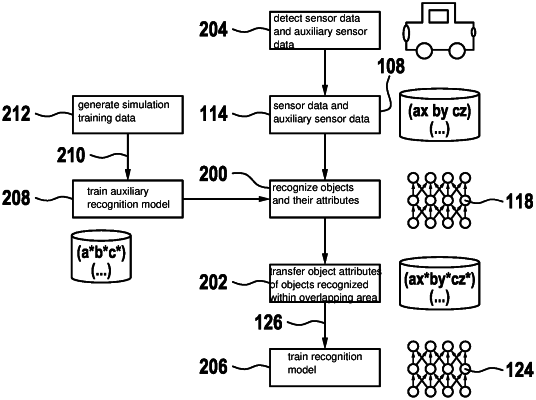| CPC G06V 20/56 (2022.01) [G06F 18/214 (2023.01); G06F 18/251 (2023.01); G06N 3/08 (2013.01); G06N 20/00 (2019.01); G06V 10/764 (2022.01); G06V 10/774 (2022.01); G06V 10/80 (2022.01); G06V 20/653 (2022.01)] | 13 Claims |

|
1. A method for generating training data for a recognition model for recognizing objects in sensor data of a sensor of an at least semi-autonomous vehicle, the method comprising:
recognizing objects and object attributes in auxiliary sensor data of an auxiliary sensor, of the at least semi-autonomous vehicle, which maps an overlapping area using a trained auxiliary recognition model; and
transferring the object attributes of the objects recognized in the overlapping area to the sensor data which maps at least the overlapping area to generate the training data;
wherein the sensor detects and maps in the sensor data a detection area ahead of the at least semi-autonomous vehicle and in the auxiliary sensor data an auxiliary detection area,
wherein the detection area and the auxiliary detection area overlap in the overlapping area, wherein the auxiliary recognition model includes an algorithm that has been trained via a training to recognize the objects in the auxiliary sensor data, wherein the training is performed using labeled samples, wherein areas including the recognized objects are marked in the labeled samples and the object attributes of the objects are stored, and wherein the auxiliary recognition model has learned to recognize the objects based on the labeled samples,
wherein the auxiliary recognition model is trained using simulation training data before recognizing the object attributes, and
wherein the simulation training data are generated using a generation model, the generation model including a sensor model of the auxiliary sensor, a propagation model, and an object model of at least one virtual object, and wherein the sensor model is used to simulate a wave emission of the auxiliary sensor and simulate a detection of a transmitted reflection by the auxiliary sensor, wherein a transmission of the wave emission through virtual surroundings including air particles and aerosols is simulated using the propagation model, and wherein a detected reflection is assigned at least one object attribute of the virtual object provided by the object model to generate the simulation training data.
|